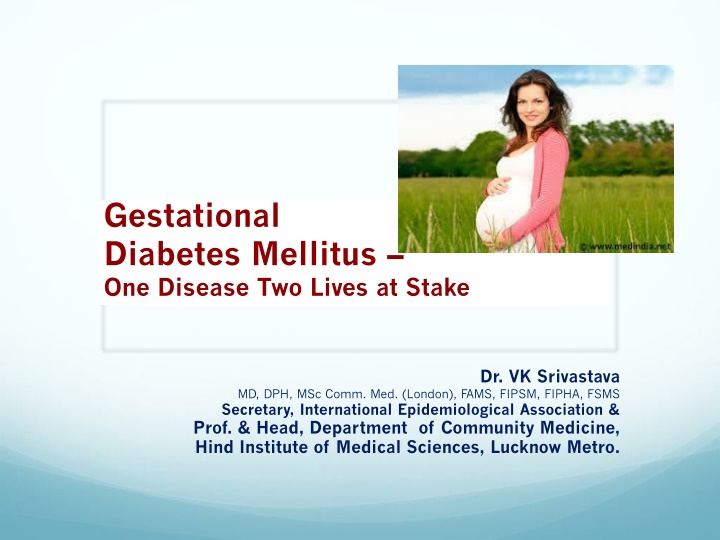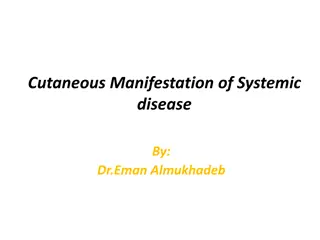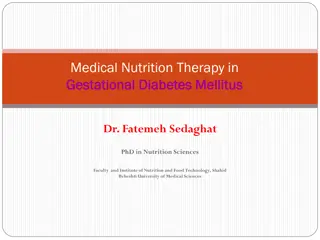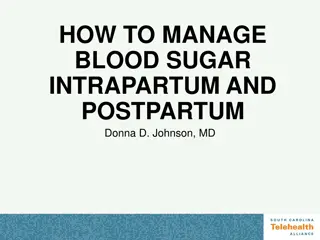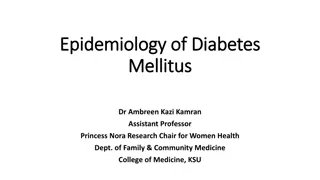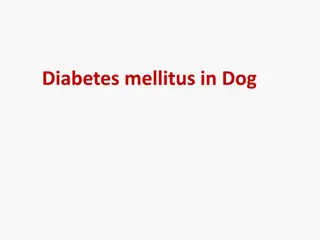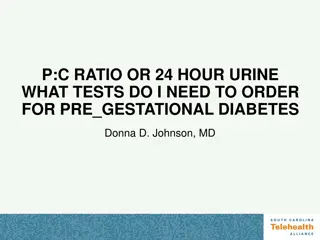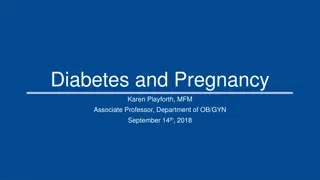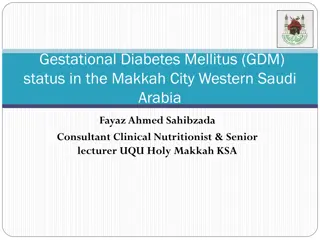Gestational Diabetes Mellitus
Gestational Diabetes Mellitus (GDM) poses significant risks to both mothers and infants, with serious complications if left undiagnosed or untreated. The prevalence of GDM is notably high in India, emphasizing the need for proper diagnosis and management as outlined in national guidelines. Understanding the pathophysiology behind GDM, its implications during pregnancy, and the vicious cycle it creates can help improve outcomes for affected individuals.
Download Presentation

Please find below an Image/Link to download the presentation.
The content on the website is provided AS IS for your information and personal use only. It may not be sold, licensed, or shared on other websites without obtaining consent from the author.If you encounter any issues during the download, it is possible that the publisher has removed the file from their server.
You are allowed to download the files provided on this website for personal or commercial use, subject to the condition that they are used lawfully. All files are the property of their respective owners.
The content on the website is provided AS IS for your information and personal use only. It may not be sold, licensed, or shared on other websites without obtaining consent from the author.
E N D
Presentation Transcript
Gestational Diabetes Mellitus One Disease Two Lives at Stake Dr. VK Srivastava MD, DPH, MSc Comm. Med. (London), FAMS, FIPSM, FIPHA, FSMS Secretary, International Epidemiological Association & Prof. & Head, Department of Community Medicine, Hind Institute of Medical Sciences, Lucknow Metro.
Introduction Gestational Diabetes Mellitus (GDM) is defined as Impaired Glucose Tolerance (IGT) with onset or first recognition during pregnancy Worldwide, one in 10 pregnancies is associated with diabetes, 90% of which are GDM Undiagnosed or inadequately treated GDM can lead to significant maternal & foetal complications Women increased risk of developing Type 2 diabetes later in life with GDM and their offsprings are at
The Problem In India, prevalence of GDM is appox.10-14.3% - much higher than the west As of 2010, India has:- 22 mill. women with diabetes in the age group of 20- 39 with an additional 54 mill. women in this age group with impaired glucose tolerance (IGT) In view of high prevalence of GDM in Indian women, Govt. of India has released National Guidelines for Diagnosis & Management of Gestational Diabetes Mellitus in Dec 2014.
Patho-physiology GDM is characterised by hyper-insulinaemia and insulin resistance In first trimester and early second trimester, increased insulin due to high levels of oestrogen In late second and early third trimesters, insulin resistance - due to a number of antagonistic hormones especially, placental lactogen, leptin, progesterone, prolactin, adiponection cortisol and
Implications of Diabetes in Pregnancy The risk of serious injury at birth - Doubles The likelihood of Caesarean delivery - Triples The incidence of Neonatal Intensive Care Unit admission - Quadruples
Pregnancy and Diabetes- The vicious cycle Pregnancy Diabetes Mellitus
Effects of Pregnancy on Diabetes During pregnancy, there is altered carbohydrate metabolism and impaired insulin action Insulin requirement increases as pregnancy advances Accelerated starvation----rapid activation of lipolysis with short period of fasting Higher risks of Ketoacidosis complications Accelerates vascular changes
Effect of Diabetes on Pregnancy: 1. Respiratory Distress Syndrome 2. Polydydramnios 3. Foetal macrosomia 4. Erb s Palsy 5. Birth asphyxia 6. Abortion/Intra uterine death 7. Neonatal hyperbilirubinemia 8. Congenital malformations
Maternal Hyperglycaemia Foetal Foetal Decreased cortisol production hyperglycaemia hyperinsulinaemia Foetal Foetal osmotic diuresis Decreased surfactant synthesis in lung hypoglycaemia Increased IGF Polyhydramnios Respiratory distress syndrome Fetal macrosomia Polyhydramnios Obstructed labour Shoulder Dystocia Erb's Palsy/ Birth Asphyxia
Chronic maternal hyperglycaemia Hyperglycaemia in 1st trimester Glycosylated Hb carries less oxygen molecule and O2 binds more avidly and releases O2 less Foetal hyperglycaemia Impaired organogenesis Foetal hyper-insulinemia Congenital abnormalities Increased foetal oxygen demand Decreased Oxygen tension (hypoxemia) Increased erythropoiesis Increase in anaerobic metabolism Polcythaemia and hyper viscosity Increased lactate and academia RBC breakdown and Neonatal hyper- bilirubinemia Abortion/ IUD
GDM: Risk Factors Age >25years BMI >25kg/m Increased weight gain during pregnancy Previous history of large for gestational age infants History of GDM during previous pregnancies previous stillbirth with pancreatic islet hyperplasia on autopsy Ethnic group ( East Asian, Pacific Island ancestry) Elevated fasting or random blood glucose levels during pregnancy Family history of diabetes in first degree relatives History of metabolic X syndrome History of type I or type II Diabetes Mellitus Unexplained fetal loss
GDM: Maternal Complications During Pregnancy Abortion Preterm labour (due to infection or polyhydramnios) Pre-eclampsia Polyhydramnios Maternal distress due to oversized fetus and polydramnios Microangiopathy- Nephropathy, retinopathy, neuropathy Large vessel disease Coronary artery disease Thromboembolic disease Infection Hypo and hyperglycaemia During labour Prolonged labour Shoulder dystocia Perineal injuries PPH Operative interference Increased risk of Caesarean delivery Puerperium Puerperal sepsis Lactational failure
GDM: Foetal Complications 2nd Trimester 1st Trimester Congenital abnormalities Macrosomia Cardiac : ASD, VSD During delivery NTD Birth asphyxia Shoulder dystocia Sacral agenesis/ CRS PCKD After delivery Renal agenesis RDS Hypoglycaemia Polycythaemia neonatal jaundice Duodenal atresia Tracheo-esophageal fistula
GESTATIONAL DIABETES PRE-EXISTING DIABETES No increased risk of congenital anomalies Increases risk of foetal macrosomia Increases risk of having Caesarean section Increased risk for metabolic syndrome and type II diabetes later in life (>50% women with gestational diabetes develop type II DM) Babies born to women with gestation diabetes are at increased risk for obesity, glucose intolerance and diabetes in adolescence Higher risk of congenital malformations and miscarriages Recurrent urinary tract infections Vulvo-vaginal infections with poor control Associated with risk of (PPPPRIM) Pre-eclampsia, Polyhydraminos, PPROM, Preterm labour, Risk of operative deliveries IUGR Macrosomia Ketoacidosis in type I, progression of microvascular complications Caesarean section rates invariably increased due to fetal macrosomia, poor blood sugar control, polyhydramnios or associated with failure of induction
The White classification, named after Priscilla White on the effect of diabetes types on perinatal outcome. It distinguishes between gestational diabetes (type A) and diabetes that existed before pregnancy (pre-gestational diabetes). There are 2 classes of gestational diabetes (diabetes which began during pregnancy): Class A1: gestational diabetes; diet controlled Class A2: gestational diabetes; medication controlled The second group of diabetes which existed before pregnancy can be split up into these classes: Class B: onset at age 20 or older or with duration of less than 10 years Class C: onset at age 10-19 or duration of 10 19 years Class D: onset before age 10 or duration greater than 20 years Class E: overt diabetes mellitus with calcified pelvic vessels Class F: diabetic nephropathy Class R: proliferative retinopathy Class RF: retinopathy and nephropathy Class H: ischemic heart disease Class T: prior kidney transplant
GDM: Diagnosis Symptoms Signs Asymtomatic Elevated serum glucose Insidious onset Glycosuria is of uncertain significance Polyuria, polyuria, polyphagia Ketonuria Fatigue and weight loss Elevated glycosylated haemoglobin Women with established diabetes may have retinopathy or neuropathy Greater than normal abdominal circumference
Principles of Management (National Guidelines for Diagnosis and Management of GDM-2014)
Who should be tested : The first testing - first antenatal contact as early as possible The second testing -24-28 weeks of pregnancy if the first test is negative At least 4 weeks gap between the two tests All Pregnant Women to be tested even if they come late in pregnancy If presents beyond 28 weeks of pregnancy-only one test to be done
How to Test: Single step testing - 75 gm oral glucose & measure plasma glucose 2 hour after ingestion 75 gm glucose mixed with 300 ml water ingested whether the PW comes in fasting or non-fasting state A plasma standardised glucometer should be used to evaluate blood glucose 2 hours after the oral glucose load The threshold plasma glucose level of 140 mg/dl is taken as cut off for diagnosis of GDM.
Antenatal care: All diabetic women are managed in a multidisciplinary combined obstetric and diabetic clinic with specialist obstetrician, diabetologist, specialist midwife, paediatrician and dietician All women should receive dietary instruction, with individual recommendations based on weight and height Patient should receive nutrition counselling from a registered dietician Daily calories should be made up approximately 40% carbohydrate, 20% proteins and 40% fats. This should improve blood glucose levels
Medical Nutritional Therapy: Recommended diet should provide 1800 Kcal/ day 50%-60% - carbohydrat e 10-20% - Proteins 25-30% - Fat
Role of Ultrasound: Preferably done in first trimester to confirm gestational age by dates Repeated at 18 to 20 weeks gestation to evaluate the foetus for congenital anomalies Particularly important in patients with pre-existing type 1 and 2 diabetes and elevated first trimester HbA1c (>6.5%) Should be done at 30 to 32 weeks and 36-38 weeks of gestation to evaluate foetal size, amniotic fluid index, and to help ascertain the mode of delivery
Tests of Foetal wellbeing Daily foetal movement counting: 32 weeks gestation and continue until delivery. Amniotic fluid index and biophysical profile. These tests are usually conducted twice weekly and are instituted at 32 to 34 weeks of gestation in women on insulin and can be done from 34-36 weeks of gestation in women whose diabetes is controlled by diet. Some clinicians manage patients with dietary control without any additional testing.
Sulfonylureas Meglitinides Biguanides Insulin secretagogues Glipizide, glyburide Decrease insulin resistance Increase insulin secretion, decrease hepatic glucose production with resultant reversal or hyperglycaemia and indirect improvement of insulin sensitivity ORAL HYPOGLYCAEMIC AGENTS Alpha glucosidase inhibitors eg acarbose) Thiazolidinediones Eg rosiglitazone and pioglitazone Decrease intestinal absorption of starch and glucose Not Recommended in National Guidelines - only Insulin to be used
Time and Mode of Delivery All pregnant women advised during the antenatal care about the potential risks of pregnancy progressing beyond term Gestational diabetes GDM on diet with no complications can be delivered at 40 weeks GDM on insulin should be delivered by induction of labour at 38-39 weeks Pre-existing diabetes Diabetes itself not an indication for Caesarean Section Pregnant women with diabetes who have a normally grown fetus should be offered elective birth through induction of labour, or by elective caesarean if indicated, after 38 completed weeks Pregnant women with ultrasound features of macrosomic fetus (fetal weight more than 4.5kg) and poorly controlled blood sugar are delivered by elective caesarean section.
Post-delivery Follow up of GDM Cases Women with GDM are at higher risk for Type 2 Diabetes mellitus. Maternal glucose levels usually return to normal after delivery. GDM cases are not discharged after 48 hours unlike others, FPG & 2 hr PPPG is performed on the 3rd day of delivery Subsequently, ANM to perform 75 g GTT at 6 weeks postpartum Cut offs for normal blood glucose values are: Fasting plasma glucose: 126 mg/dl 75 g OGTT 2 hour plasma glucose Normal: < 140 mg/dl IGT: 140-199mg/dl Diabetes: 200 mg/dl
Operational Aspects of National GDM Guidelines
Role of Health Personnel at different levels of Health Facility: Village Level ASHA: To mobilise & counsel PW for timely testing & follow up Sub-centre Level ANM: Testing/MNT/Referral of cases needing medical management Maintaining records, monitoring & follow up
Role of Health Personnel at different levels of Health Facility...contd. PHC/ UPHC Level GDM controlled on MNT can be delivered by ANM/SN GDM on Medical management with Insulin therapy- by MOs GDM not controlled by Insulin therapy/GDM with complications should to referred to higher facility for care by a specialist Maintaining records, monitoring & follow up
Role of Health Personnel at different levels of Health Facility ..contd. DH & All CEmOC centres All jobs as defined under PHC level + Specialist/Gynaecologist/MO: Management of all types of GDM cases MC & other Super-speciality centres Comprehensive management of GDM including all referral cases
Capacity building of Health personnel under GDM Guidelines
Screening for GDM Most patients with GDM have normal fasting glucose levels. The challenge of glucose tolerance must be done for most cases with GDM.
Screening at the 24 weeks visit OGTT should be done. There are some controversies. whether the universal or selective OGTT should be done? Which blood glucose level should be the optimal cutoff for diagnosis?
Screening Strategy Every pregnant woman to undergo OGTT at about 24 weeks of gestation. If the GDM symptoms are present after 24 weeks, the OGTT should be done again.
Ante-partum Management There is a consensus that once diabetes is diagnosed, the treatment should be recommended for diabetes during pregnancy. The goals of treatment are to prevent macrosomia, avoid ketosis, and detect pregnancy complications (eg, hypertension, intrauterine growth restriction, and fetal distress). The management includes diet, exercise and insulin.
Diet Therapy The goals of diet therapy in GDM are to avoid ketosis, achieve normal blood glucose levels, obtain proper nutrition, and gain weight appropriately. The amount and distribution of carbohydrate should be based on clinical outcome measures (eg, hunger, blood glucose levels, weight gain), but a minimum of 175 g of carbohydrate per day should be provided. Carbohydrate should be distributed throughout the day in 5 to 7 meals and snacks. Use of a low glycemic index diet decreases the need for insulinto maintain euglycemia.
Exercise Experts recommend that women with GDM should exercise regularly to control blood glucose levels. but an improvement in clinical outcomes has not been demonstrated from compliance with this recommendation.
Insulin Therapy Traditionally, insulin is used if dietary management does not maintain blood glucose at normal levels. Insulin may be initiated at 0.7 U/kg actual body weight/d given in divided dosages: two-thirds of the daily dosage before breakfast and the remainder of the dosage before dinner. Insulin therapy require close monitoring and adjustment based on blood glucose levels, meal choices, and activity levels.
Obstetrics Management The goal of intra-partum GDM management is to avoid operative delivery, shoulder dystocia, birth trauma, and neonatal hypoglycemia. For patients who have maintained excellent control of blood glucose levels with diet and exercise, delivery is recommended at 40 weeks. For patients with medication-requiring GDM, induction at 38 to 39 weeks gestation is recommended
Obstetrics managementcontd In general, women with gestational diabetes who do not require insulin seldom require early delivery or other interventions. Elective cesarean delivery to avoid brachial plexus injuries in macrosomic infants is an important issue.
Postpartum Management In most women with GDM, hyperglycemia rapidly resolves shortly after delivery. It is reasonable to measure a single random or fasting blood glucose level before discharge from the hospital.
